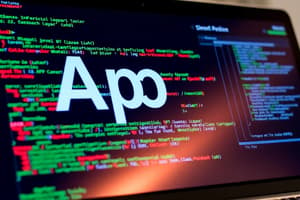Podcast
Questions and Answers
Which programming technique focuses on breaking down a problem into smaller, manageable sub-problems?
Which programming technique focuses on breaking down a problem into smaller, manageable sub-problems?
- Recursion (correct)
- Modularization
- Iteration
- Abstraction
What is the primary purpose of using modularization in programming?
What is the primary purpose of using modularization in programming?
- To increase the code complexity
- To reduce the total number of functions
- To make debugging more challenging
- To enhance collaboration among developers (correct)
Which of the following best describes the concept of abstraction in programming?
Which of the following best describes the concept of abstraction in programming?
- Using only high-level languages for development
- Creating multiple copies of the same function for different usages
- Combining several functions into a single complex function
- Hiding the implementation details while exposing only the necessary parts (correct)
Which programming technique is primarily used to control the flow of execution in a program?
Which programming technique is primarily used to control the flow of execution in a program?
In which scenario is using iteration more beneficial than recursion?
In which scenario is using iteration more beneficial than recursion?
Flashcards
Programming Techniques
Programming Techniques
Methods and strategies used to write effective and efficient computer programs.
Algorithm
Algorithm
A step-by-step procedure for solving a problem.
Debugging
Debugging
The process of finding and resolving errors in a program.
Data Structures
Data Structures
Signup and view all the flashcards
Coding Style
Coding Style
Signup and view all the flashcards
Study Notes
Multiple Choice Questions (MCQs)
-
Which of the following is NOT a fundamental programming paradigm?
-
a) Procedural
-
b) Object-Oriented
-
c) Functional
-
d) Logical
-
e) Graphical
-
What is the primary purpose of a compiler?
-
a) To execute source code directly.
-
b) To translate source code into machine code.
-
c) To debug source code.
-
d) To generate documentation from code.
-
What does DRY stand for in software development?
-
a) Don't Repeat Yourself
-
b) Do Repeat Yourself
-
c) Design Rules You
-
d) Detailed Reporting Yourself
-
Which data structure allows for efficient insertion and deletion at both ends?
-
a) Array
-
b) Linked List
-
c) Stack
-
d) Queue
-
What is the key characteristic of a recursive function?
-
a) It always returns an integer value.
-
b) It calls itself within its own definition.
-
c) It is always faster than iterative solutions.
-
d) It must have a loop in it.
Questions
- Explain the difference between procedural and object-oriented programming paradigms.
- Describe the role of a debugger in the software development life cycle.
- What are the advantages and disadvantages of using recursion in programming?
- Illustrate with examples how different data structures (e.g., arrays, linked lists, stacks, queues) are implemented and used to solve problems.
- Give examples of common programming errors and how to troubleshoot them.
- Discuss the importance of code readability and documentation in the context of software development.
Study Notes: Programming Techniques
Fundamental Programming Paradigms
-
Procedural: Focuses on procedures or functions that operate on data. Sequence of steps to solve a problem (Example: C).
-
Object-Oriented: Organizes software design around objects, which combine data and methods (functions) that operate on that data. Real-world entities as programming constructs (Example: Java, Python).
-
Functional: Emphasizes the evaluation of mathematical functions. Avoids changing state or side effects, instead focuses on immutability & reusability. (Example: Lisp, Haskell).
-
Logical: Based on formal logic, suitable for problems that can be stated in terms of facts, rules, and queries. (Example: Prolog).
-
Graphical / visual: The use of graphical elements to compose and manipulate procedures like in flowcharts or visual programming environments.
Programming Languages
- Different languages excel at different tasks:
- Python: general purpse, excellent for scripting, data analysis
- Java: object-oriented, large enterprise applications
- C++: system programming, performance-critical applications.
- C#: primarily Windows applications.
- JavaScript: front-end web development.
Data Structures
- Arrays: Ordered collections of elements of the same data type. Efficient access by index but not for insertion/deletion.
- Linked Lists: Ordered collections of data where each element (node) holds a reference to the next element. Enables dynamic sizing.
- Stacks: LIFO (Last-In, First-Out) data structure. Useful for function calls, undo operations.
- Queues: FIFO (First-In, First-Out) data structure. Useful for managing tasks in order of arrival.
Algorithms
- Algorithms are step-by-step procedures for solving a specific problem.
- Efficiency is measured in time and space complexity.
- Common algorithms include searching (linear, binary), sorting (bubble, merge, quick), graph algorithms (traversal, shortest paths).
Problem-Solving
- Decompose a problem into smaller manageable pieces.
- Choose the appropriate data structures and algorithms for solving the problem.
- Test your code thoroughly to ensure correctness.
Debugging
- Identify the source of the error.
- Use debugging tools to step through your code.
- Review your code for syntax and logical errors.
- Employ logging to effectively trace the execution flow.
Code Readability
- Use meaningful variable names.
- Write well-commented code.
- Break down code into reusable functions.
- Follow consistent coding style.
Software Development Life Cycle (SDLC)
- Phases include planning, design, development, testing, deployment, and maintenance.
- Iterative approach with feedback loops can improve quality and efficiency during development.
- Emphasizing testing at each phase is critical for quality assurance.
Tools
- Compilers: translate source code into machine code.
- Interpreters: execute source code directly.
- Debuggers: help identify and fix errors in code.
Studying That Suits You
Use AI to generate personalized quizzes and flashcards to suit your learning preferences.




